ABOUT AUTHOR:
Neha Singh
M.Pharm ( department of pharmaceutics)
Noida institute of engineering and technology.
neha8april@gmail.com
ABSTRACT:
Swine flu has been creating a terror effects all round the globe and has been declared epidemic in most part of the world. Swine flu refers to swine influenza or the viral infection caused by any of the several types of swine influenza virus. Only people who used to have direct contact with pigs were observed to get swine flu in the past. But, H1N1 virus is a new swine flu virus and it contains the genetic material of swine, bird and human influenza virus. H1N1 is an Influenza A virus. Swine flu can produce a number of symptoms in both adults and children. In India day by day the graph of infected person has been climbed up so, it is important to take into consideration about this disease as it may prove deadly one. The intensity of this disorder can be lowered by diagnosing and taking proper treatments.
REFERENCE ID: PHARMATUTOR-ART-1812
INTRODUCTION:
Swine flu is an emerging viral infection that is a present global public health problem. There are many thousands cases of swine flu in the present day. This new infection can be seen around the world in the present day. This infection is a kind of variant of H1N1 influenza infection (Figure 1). The problematic virus was firstly detected in America in 2009 and this virus is the most widely studied virus in the present day. Due to the nature of respiratory virus, the transmission of this pathogenic virus is air borne transmission. Hence, the rapid spreading and difficulty in control of this infection can be expected. Swine flu, also called pig influenza, swine influenza, hog flu and pig flu. Swine influenza virus (SIV) or S-OIV (swine-origin influenza virus) is any strain of the influenza family of viruses that is endemic in pigs.1,2
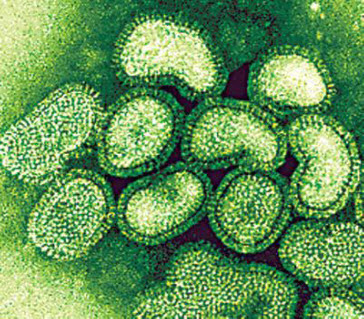
Figure 1 Electron microscope image of the reasserted H1N1 influenza virus
INFLUENZA
Commonly referred to as the flu, is an infectious disease caused by RNA viruses of the family Orthomyxoviridae (the influenza viruses), that affects birds and mammals. The most common symptoms of the disease are chills, fever, sore throat, muscle pains, severe headache, coughing, weakness/fatigue and general discomfort.1 Sore throat, fever and coughs are the most frequent symptoms. In more serious cases, influenza causes pneumonia, which can be fatal, particularly for the young and the elderly. Although it is often confused with other influenza?like illnesses, especially the common cold, influenza is a more severe disease than the common cold and is caused by a different type of virus. Influenza may produce nausea and vomiting, particularly in children, but these symptoms are more common in the unrelated gastroenteritis, which is sometimes called "stomach flu" or "24 hour flu". Typically, influenza is transmitted through the air by coughs or sneezes, creating aerosols containing the virus.2
STRUCTURE OF INFLUENZA:
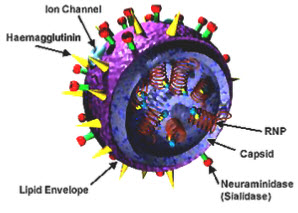
Influenza can also be transmitted by direct contact with bird droppings or nasal secretions, or through contact with contaminated surfaces. Airborne aerosols have been thought to cause most infections, although which means of transmission is most important is not absolutely clear. Influenza viruses can be inactivated by sunlight, disinfectants and detergents. As the virus can be inactivated by soap, frequent hand washing reduces the risk of infection.3
CLASSIFICATION
1. Influenza virus A
2. Influenza virus B
3. Influenza virus C
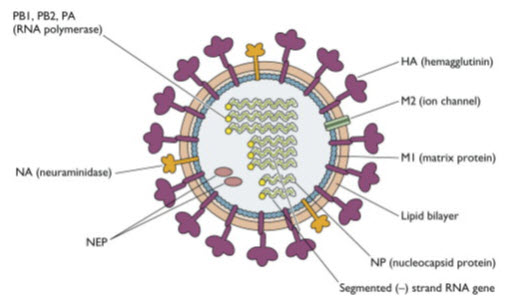
Fig. 2: "The gene structure and replication of influenza virus".
Annu. Rev. Biochem. 52: 467–506
TYPES OF FLU:4,5
1. Bird flu or Avian Flu
2. Swine flu in 2009
3. H1N1, which caused Spanish Flu in 1918
4. H3N2, which caused Hong Kong Flu in 1968
5. H2N2, which caused Asian Flu in 1957
BIRD FLU-
Also called: Avian flu, Avian influenza, H5N1 Bird flu viruses infect birds,including chickens, other poultry and wild birds such as ducks. Most bird flu viruses can only infect other birds. However, bird flu can pose health risks to people. The first case of a bird flu virus infecting a person directly, H5N1, was in Hong Kong in 1997. Since then, the bird flu virus has spread to birds in countries in Asia, Africa and Europe. Human infection is still very rare, but the virus that causes the infection in birds might change, or mutate, to more easily infect humans. This could lead to a pandemic, or a worldwide outbreak of the illness.
During an outbreak of bird flu, people who have contact with infected birds can become sick. It may also be possible to catch bird flu by eating poultry that is not well cooked or through contact with a person who has it. Bird flu can make people very sick or even cause death. There is currently no vaccine.
FLU-
Also called: Grippe, Influenza Flu is a respiratory infection caused by a number of viruses. The viruses pass through the air and enter your body through your nose or mouth. Between 5% and 20% of people in the U.S. get the flu each year. The flu can be serious or even deadly for elderly people, newborn babies and people with certain chronic illnesses.
Symptoms of the flu come on suddenly and are worse than those of the common cold. They may include
• Body or muscle aches
• Chills
• Cough
• Fever
• Headache
• Sore throat
SWINE FLU-
Swine flu is an infection caused by a virus. Swine flu is also known as swine influenza, hog flu and pig flu. In 2009 the media labeled as "swine flu" the flu caused by 2009's new strain of swine origin A/H1N1 pandemic virus just as it had earlier dubbed as "avian flu" flu caused by the recent Asian linage HPAI (High Pathogenic Avian Influenza) H5N1 strain that is still endemic in many wild bird species in several countries.
Swine influenza is an infection by any one of several types of swine influenza virus. Swine influenza virus (SIV) or S-OIV (swine origin influenza virus) is any strain of the influenza family of viruses that is endemic in pigs. As of 2009, the known SIV strains include influenza
C and the subtypes of influenza A known as H1N1, H1N2, H3N1, H3N2, and H2N3.Swine influenza virus is common throughout pig populations worldwide.
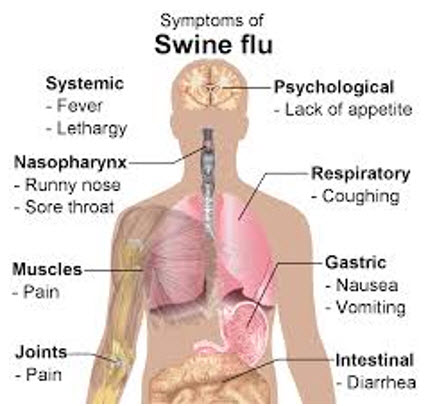
Fig 3: symptoms of swine flu.20
20th century flu pandemics
|
Pandemic |
Year |
Influenza A virus subtype |
People infected (approx) |
Deaths (est.) |
Case fatality rate |
|
1918 flu |
1918-19 |
H1N1 |
0.5 to 1 billion (near 50%) |
20 to 100 million |
>2.5% |
|
Pandemic Asian flu |
1956-58 |
H2N2 |
|
2 million |
<0.1% |
|
Hong kong flu |
1968-69 |
H3N2 |
|
1 million |
<0.1% |
|
Seasonal flu |
Every year |
MainlyA/H3N2, A/H1N1,and B |
5–15% (340 million – 1 billion) |
250,000–500,000 per year |
<0.05% |
How SWINE FLU Spread? 6
Like most viruses, it enters the body through the mucous membranes - the eyes, the nose or the mouth. Swine flu is spread just like the regular seasonal flu spreads. It goes from person to person through close contact and direct touch, indirect touch, or respiratory droplets that carrying the virus. Infected person may be able to infect others beginning one day before symptoms develop and up to seven or more days after becoming sick. Infected people may be able to infect others beginning 1 day before symptoms develop and up to 7 or more days after becoming sick.
People with swine influenza virus infection should be considered potentially contagious as long as they are symptomatic and possible for up to 7 days following illness onset. Children, especially younger children, might potentially be contagious for longer periods. Swine influenza viruses are not transmitted by food. Any person cannot get swine influenza from eating pork or pork products. Eating properly handled and cooked pork and pork products are safe. Cooking pork to an internal temperature of 160°F (72°C) kills the swine flu virus as it does other bacteria and viruses.
WHAT IS THE SWINE FLU INCUBATION PERIOD?7
Every virus, bacteria or pathogen of any time has a certain incubation period. This period is the time it takes after the pathogen enters the body, for the symptoms to appear. Like all influenza pathogens the average incubation period is two days. However, studies have shown individual periods to range between one day to seven days, over all. As such, there is quite a dispute all over the world about the incubation period. Hence, as a suggestion it would be wise to keep an eye out for approximately 10 days to be sure of the infection. Most US cases have shown the incubation period to be between two to seven days.
WHO ARE PRONE TO INFECTION WITH SWINE FLU?
Older age group 65 yr
* Pregnant woman
* Individuals with chronic lung disease
* Individuals with congestive heart failure
* Individuals with renal failure
* Immunosuppressant
* Hematological abnormalities
* Individuals with Diabetes mellitus
* Individuals with chronic hepatic disease
* Socially unable to cope
* Individuals with asthma
SIGNS AND SYMPTOMS 8,9,10
In Swine
In pigs influenza infection produces fever, lethargy, sneezing, coughing, difficulty breathing and decreased appetite.
In Humans
Symptoms include fever, cough, sore throat, body aches, headache, chills and fatigue. The 2009 outbreak has shown an increased percentage of patients reporting diarrhea and vomiting. The 2009 H1N1 virus is not zoonotic swine flu, as it is not transmitted from pigs to humans, but from person to person.
Sign and Symptoms of Swine flu: 12,13
In children
Rapid Breathing or Difficulty in breathing.
Grayish or Bluish Skin Color
Dehydration
Persistent of severe vomiting
Not able to interact properly with people,
become irritable
Flu like symptoms, bad cough and fever
In adults11
Shortness of breath or difficulty in breathing
Pain in chest or abdomen
Sudden dizziness or loss of energy
Severe or continuous vomiting
Flu like symptoms, bad cough and fever
TRANSMISSION:
1. Transmission between pigs
Influenza is quite common in pigs, with about half of breeding pigs having been exposed to the virus in the US. Antibodies to the virus are also common in pigs in other countries. The main route of transmission is through direct contact between infected and uninfected animals. These close contacts are particularly common during animal transport. Intensive farming may also increase the risk of transmission, as the pigs are raised in very close proximity to each other. The direct transfer of the virus probably occurs either by pigs touching noses, or through dried mucus. Airborne transmission through the aerosols produced by pigs coughing or sneezing are also an important means of infection. The virus usually spreads quickly through a herd, infecting all the pigs within just a few days. Transmission may also occur through wild animals, such as wild boar, which can spread the disease between farms.14,16
2. Transmission to humans
People who work with poultry and swine, especially people with intense exposures, are at increased risk of zoonotic infection with influenza virus endemic in these animals, and constitute a population of human hosts in which zoonosis and reassortment can co-occur. Vaccination of these workers against influenza and surveillance for new influenza strains among this population may therefore be an important public health measure. Transmission of influenza from swine to humans who work with swine was documented in a small surveillance study performed in 2004 at the University of Iowa. This study among others forms the basis of a recommendation that people whose jobs involve handling poultry and swine be the focus of increased public health surveillance. Other professions at particular risk of infection are veterinarians and meat processing workers, although the risk of infection for both of these groups is lower than that of farm workers.15,17
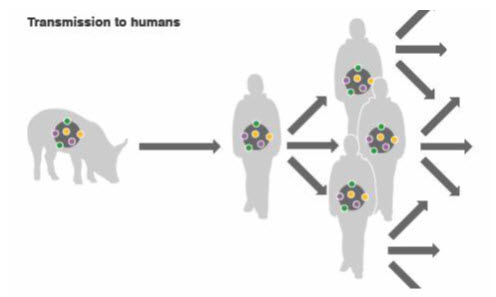
DIAGNOSIS:
For diagnosis of swine influenza A infection, respiratory specimen (nasopharyngeal swab, throat swab nasal aspirate, nasal washing) would generally need to be collected within the first 4 to 5 days of illness (when an infected person is most likely to be shedding virus). Most of the tests can distinguish between A and B types. The test can be negative (no H1N1 infection) or positive for type A and B. If the test is positive for type B, the flu is not likely to be swine influenza (H1N1). If it is positive for type A, the person could have conventional influenza strain or swine influenza (H1N1).
SAMPLE COLLECTION:
It should be labeled clearly and include patient’s complete information and should be sent to NIV, Pune or NICD, Delhi within 24 hours for further investigations. Laboratory biosafety measures should be followed for collection, storage, packaging and shipping of influenza samples.
AVAILABLE LABORATORY TESTS:
* Rapid Antigen Tests: not as sensitive as other available tests.
* RT–PCR: In this detection and quantification of mRNA is done. This test detects the viral load in an individual.
* Virus isolation: The throat swab is generally taken to culture virus from the suspected cases. Though if it is not detected doesn’t rule out the disease.
* Virus Genome Sequencing
TREATMENT OF SWINE FLU:
Oseltamivir is the recommended anti viral drug for the treatment or prevention of infection with the influenza A H1N1. The Mayo Clinic and Medline list a number of ways to help ease symptoms, including adequate liquid intake and rest, soup to ease congestion, and overthe-counter drugs to relieve pain. Aspirin, for instance, "is very effective for treating fever in adults" although in children and adolescents, aspirin is not usually given due to the risk of Reye's syndrome while over-the-counter drugs relieve symptoms, they do not kill the virus. Most patients were expected to recover without medical attention, although those with pre-existing or underlying medical conditions were more prone to complications. According to the CDC, antiviral drugs can be given to treat those who become severely ill, two of which are recommended for swine flu symptoms: oseltamivir (Tamiflu) and zanamivir (Relenza). To be most useful, they must be taken within 2 days of showing symptoms. They work by deactivating an enzyme the virus needs to grow and spread. Therefore, when taken soon after symptoms are noticed, "they may shorten the illness by a day or so," according to the Mayo Clinic. Oseltamivir is an oral medication, but zanamivir is inhaled through a device similar to an asthma inhaler and shouldn't be used by anyone with respiratory conditions, such as asthma and lung disease.
VACCINES-
Vaccines have been developed to protect against the virus that causes swine flu. There are two different brands of vaccine –Pandemrix and Celvapan. Many people given the Pandemrix vaccine will only need one dose. People who have the Celvapan vaccine will need two doses three weeks apart. Is it the same as the seasonal flu vaccination No. The swine flu vaccine is different from the seasonal flu vaccination that’s offered every year. The seasonal flu vaccine does not protect against swine flu. If you are usually advised to have the seasonal flu vaccination, you should have it. You may be offered the swine flu vaccine as well. The seasonal flu vaccine does not protect against swine flu.16,18
PREVENTION OF SWINE FLU INFECTION:
The CDC recommends taking these steps:
• Wash your hands regularly with soap and water, especially after coughing or sneezing. Scrub for at least 20 seconds and rinse thoroughly.
• If soap and water are not available, wash your hands with an alcohol-based hand gel. Rub your hands together until the alcohol dries completely.
• Avoid close contact that is, being within 6 feet with people who have flu like symptoms.
• Avoid touching your mouth, nose, or eyes. That's not easy to do, so keep those hands clean.
• If you have flu like symptoms fever plus at least cough or sore throat or other flu symptoms stay home for seven days after symptoms begin or until you've been symptom free for 24 hours whichever is longer.
• Wear a face mask (consider using an N95 respirator) if you must come into close contact with a sick person. "Close contact" means within 6 feet. Note: There is no definitive proof that a face mask prevents flu transmission. Do not rely solely on a face mask to prevent infection.
• Wear an N95 respirator if helping a sick person with a nebulizer, inhaler, or other respiratory treatment.
Note: There is no definitive proof that a respirator prevents flu transmission. Do not rely solely on a respirator to prevent infection.
• People who have or are suspected of having swine flu should wear a face mask, if available and tolerable, when sharing common spaces with other household members, when outside the home, or when near children or infants.
• Breastfeeding mothers with swine flu symptoms should express their breast milk, and the child should be fed by someone else.18,19
PERSONAL PROTECTION EQUIPMENTS-
PPE reduces the risk of infection if used correctly.
It includes:
• Gloves (nonsterile),
• Mask (high efficiency mask) / Three layered surgical mask,
• Long sleeved cuffed gown,
• Protective eyewear (goggles/visors/face shields),
• Cap (may be used in high risk situations where there may be increased aerosols),
• Plastic apron if splashing of blood, body fluids, excretions and secretions is anticipated.19
REFERENCES:
1. Wiwanitkit V. Swine Flu: The Present Pandemic Infectious Disease. Kulak Burun Bogaz Ihtis Derg., 2009; 19(2):57-61.
2. Swine influenza. The Merck Veterinary Manual. 2008. ISBN 1442167424. merckvetmanual.com/mvm/index.jsp?cfile=htm/bc/121407.htm. Retrieved April 30, 2009.
3. Swine Flu India Guide. Everything You Need to Know to Protect Yourself and Your Family. swineflu-india.org
4. "Hijacking of the host?cell response and translational control during influenza virus infection". Virus Res 119 (1): 111–20.
5. "Assembly and budding of influenza virus". Virus Res 106 (2):147–65.
6. wiki.answers.com/Q/How_is_swine_flu_spread
7. buzzle.com/articles/swine-flu-natural-remedies-herbal-remedies-for-swine flu.html
8. "Q & A: Key facts about swine influenza (swine flu) – Spread of Swine Flu". Centers for Disease Control and Prevention. cdc.gov/
9. CDC H1N1 Flu | H1N1 Flu and You. Cdc.gov. cdc.gov/H1N1flu/qa.htm.
10. Kothalawala H, Toussaint MJ, Gruys E. An Overview of Swine Influenza". Vet Q., 2006; 28 (2): 46–53.
11. Centers for Disease Control and Prevention > Key Facts about Swine Influenza (Swine Flu). cdc.gov/swineflu/key_facts.htm
12. Myers KP, Olsen CW, Gray GC. Cases of swine influenza in humans: a review of the literature. Clinical Infectious Diseases, 2007; 44 (8): 1084–8.
13. "Understanding the symptoms of the common cold and influenza". Lancet Infect Dis 5 (11): 718–25
14. CDC H1N1 Flu | H1N1 Flu and You". Cdc.gov. cdc.gov/H1N1flu/qa.htm
15. FDA Approves Vaccines for 2009 H1N1 Influenza Virus". FDA. fda.gov
16. "Influenza: evolving strategies in treatment and prevention".Semin Respir Crit Care Med 28 (2): 144–58.
17. Wikepedia.com
18. cdc.gov/swineflu
19. orderline.dh.gov.uk
20. google.co.in
NOW YOU CAN ALSO PUBLISH YOUR ARTICLE ONLINE.
SUBMIT YOUR ARTICLE/PROJECT AT articles@pharmatutor.org
Subscribe to Pharmatutor Alerts by Email
FIND OUT MORE ARTICLES AT OUR DATABASE









